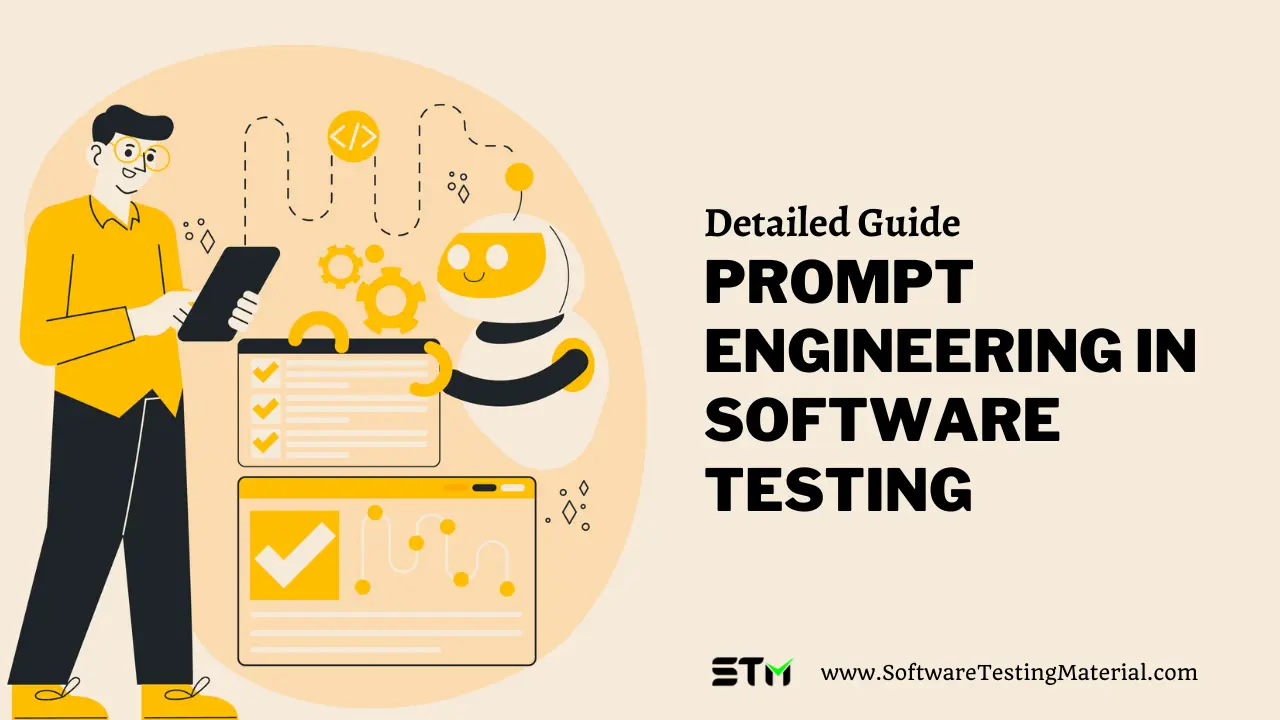Prompt Engineering in Software Testing | Everything You Should Know
In the era of artificial intelligence (AI), Prompt Engineering in Software Testing is no longer just a trend; it’s rapidly becoming an essential skill for modern software testers. As AI becomes more prevalent in applications, the ability to effectively interact with these systems to test their capabilities becomes crucial.
Testers proficient in Prompt Engineering can accurately evaluate AI software, ensuring it functions as intended in various scenarios.
Must read: How To Ace AI Job Interview & AI Interview Questions & Answers
This expertise enables them to craft precise prompts that gauge how well AI comprehends and responds to human language, vital for assessing the reliability and usability of AI features.
In a nutshell, with AI shaping software development, testers with Prompt Engineering skills will play a pivotal role in creating smarter, more user-friendly applications.
Must read: How To Become A Game Tester

In this article, we will explore what prompt engineering is, why it is important in software testing and the following.
What is Prompt Engineering?
Prompt engineering is the process of skillfully crafting precise and effective prompts or instructions to a Generative AI tool to guide it in providing the specific response you want.
Imagine you’re teaching a friend how to bake a cake. You’d provide clear step-by-step instructions, wouldn’t you? That’s exactly what prompt engineering does with an AI model. It’s all about creating the right ‘instructions’ or ‘prompts’ to help the AI understand what you’re asking for and give you the best possible answer.
Large Language Models (LLM) like ChatGPT, Bard, and other prominent LLMs generate responses based on the prompts or instructions provided. However, the outcomes vary significantly depending on the words or instructions used. When instructions are a bit vague and imprecise, the outcomes might fall short of expectations.
Prompt engineering involves carefully crafting inputs to extract more precise, accurate, and valuable content from these advanced AI systems.
Large Language Model (LLM) systems utilize natural language processing (NLP) to interpret the input provided. These systems convert questions or instructions (known as prompts) into code, which is then processed through their extensive data repositories to generate content in the specified format (such as text, images, or code).
What is Prompt Engineering in Software Testing?
Prompt Engineering in Software Testing signifies a revolutionary shift in the way tests are designed, developed, and executed.
It leverages the power of Generative AI to create more dynamic, intelligent testing scenarios that closely mimic real-world user interactions.
By crafting precise and targeted prompts, developers and testers can guide AI-powered testing tools to generate comprehensive testing scripts, identify potential bugs, or simulate user interactions with the software.
By doing so, not only does it streamline test creation and execution processes, but it also enhances test accuracy and relevance to real-world scenarios while reducing manual efforts.
This approach not only accelerates the test creation process but also enhances the reliability and robustness of software. It ensures that tests are thorough and adaptable to evolving features and functionalities, enhancing the software’s quality.
Through prompt engineering, testers can guide the AI to think beyond standard test cases, exploring edge cases and nuanced behaviors that might otherwise be overlooked.
This innovative approach marks a significant leap towards more efficient, effective, and intelligent software testing methodologies.
Why Prompt Engineering is Important in Software Testing
Prompt engineering is very important in software testing because it helps testers and AI work better together. Even testers who aren’t experts in coding can still do advanced tests. This way, software can be made better and more reliable for everyone.
- Enables Precision: Prompt engineering fine-tunes AI applications to meet the specific needs of software testing, ensuring that testing is both thorough and precise.
- Enhances Efficiency: By bridging the gap between human testers and AI capabilities, testing processes become more streamlined, leading to a significant reduction in the time required to detect and fix issues.
- Reduces Human Error: Leveraging AI for testing minimizes the risk of human errors that can occur due to oversight, thus improving the overall quality of the software.
- Facilitates Comprehensive Testing: AI-powered prompt engineering allows for the creation of a vast array of test scenarios, including edge cases that human testers might not foresee.
- Improves Test Coverage: With the ability to quickly generate and execute tests, prompt engineering ensures a wider range of the software’s functionalities are tested, leading to more robust and reliable products.
- Improved Test Data Generation: AI has the capability to create a wide range of authentic test data, crucial for assessing the strength and scalability of applications.
- Supports Agile Development: The agility offered by prompt engineering aligns perfectly with the principles of agile development, enabling rapid iterations and adjustments based on real-time feedback.
- Democratizes Testing: It levels the playing field, allowing testers of varying technical expertise to utilize advanced AI tools and techniques, making quality testing accessible to a broader audience.
Where can we apply prompt engineering in Software Testing
Prompt engineering can be strategically applied in several areas of software testing to significantly enhance efficiency and effectiveness.
Test Case Generation: AI models can be utilized to automatically generate test cases that adhere to specifications and requirements. These test cases cover a wide range of scenarios.
Exploratory Testing: AI helps out with exploratory testing by suggesting test paths and interactions, making it easier for testers to find unexpected issues.
Automation Testing: Effective prompts can automate complex AI-driven test cases, replicating diverse user interactions for thorough software testing without manual input. This accelerates testing and uncovers potential issues in various conditions beyond human foresight.
Performance Testing: Prompts can be used to simulate high volumes of user traffic or various user behaviors, thus assessing the software’s scalability and resilience under stress.
Security Testing: Enables testers to craft prompts that mimic malicious attacks or unusual user behavior, thereby identifying vulnerabilities before they can be exploited.
User acceptance testing (UAT): Prompt engineering helps create realistic scenarios & user stories for testers to assess software meeting user needs effectively. By integrating it into UAT, testers ensure the software works technically and offers an intuitive user experience.
Tips for Effective Prompt Engineering
Being a prompt engineer might sound complicated, but it boils down to guiding an advanced AI in understanding and executing your requests efficiently. Here are some straightforward tips to kickstart your prompt engineering:
- Be Clear and Direct: Think of the AI as a very literal-minded friend. It wants to help you, but you need to be precise in what you’re asking for. Instead of saying “I need help with my project,” say “I need a detailed plan for a science project on renewable energy for grade 8 students.”
- Provide Context: Giving a bit of background can make a huge difference. If you’re asking for advice on coding, mentioning the programming language can help the AI tailor its advice specifically for you.
- Simple Steps Are Key: Break down your request into smaller, more manageable steps. This not only makes it easier for the AI to follow but also helps you organize your thoughts and needs.
- State Your End Goal: Be clear about what you’re hoping to achieve with the AI’s assistance. Knowing the end goal helps the AI to tailor the information or solution it provides, making sure it’s useful for you.
- Feedback Loop: Like learning a new language, practice makes perfect. If the initial response isn’t quite what you were hoping for, try tweaking your prompts. This is a great way to learn what works best and refine your approach.
Remember, prompt engineering is a skill that improves with practice. The more you interact and experiment with different prompts, the better you’ll become at communicating your needs effectively to the AI.
Conclusion
In conclusion, the integration of Prompt Engineering into software testing, especially in the realm of artificial intelligence (AI), is not just a trend but a necessity for professionals aiming to stay relevant in their field.
For freshers entering the dynamic world of software development and testing, understanding the nuances of Prompt Engineering can be the key to unlocking innovative testing strategies and enhancing the efficiency and accuracy of AI-based applications.
It empowers testers to craft precise prompts that guide AI systems toward generating expected outcomes, thereby streamlining the testing process and reducing errors.
As AI continues to evolve, the role of Prompt Engineering in software testing will undoubtedly become more critical, making it an essential skill for newcomers to master.
Related posts:
- How To Become A Prompt Engineer (Step By Step Guide)
- 30+ Prompt Engineering Interview Questions
- Artificial Intelligence In Software Testing
- Generative AI In Software Testing
- AI Testing | Everything You Should Know
- What is Software Testing | Everything You Should Know
- Best Artificial Intelligence Tools
- Best AI Testing Tools
- Automation Testing Interview Questions
- Manual Testing Interview Questions
- Software Development Life Cycle (SDLC) – Complete Guide
- Software Testing Life Cycle (STLC) – Complete Guide
- Bug Life Cycle (Defect Life Cycle) – Complete Guide
- 100+ Types of Software Testing






